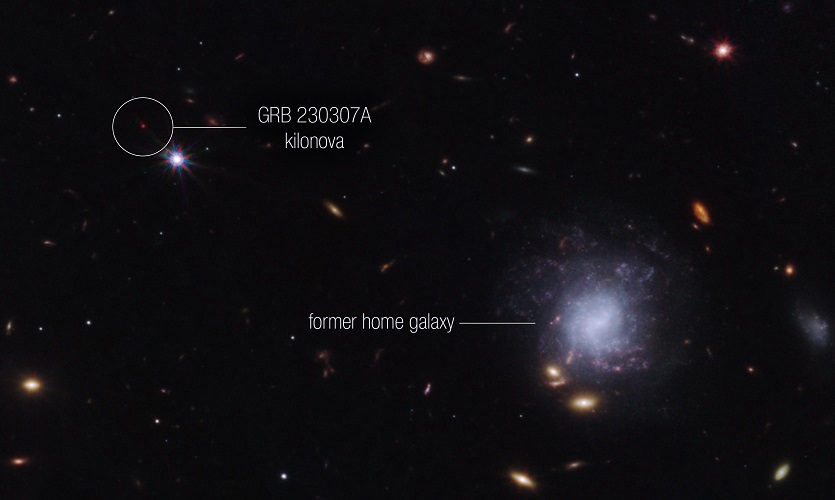On the origins of heavy metals

The mystery around the origins of heavy metals in the Universe has been solved, at least partly.
A group of international physicists, including from Liverpool John Moores University (LJMU), NASA and over 60 other institutions have observed the synthesis of the elements Tungsten, Selenium, and Tellurium in the aftermath of a gamma ray burst.
This makes gamma-ray bursts the only observationally confirmed source for the creation of the heaviest elements in the periodic table.
Heavy metals – those heavier than iron via their atomic mass – are natural components of the Earth's crust and some – zinc, selenium - are vital in small quantities to maintain the metabolism of the human body.
“We were searching for the signature of heavy metal synthesis within the Universe and it took a gigantic explosion to allow us to see it,” explains Dr Gavin Lamb of LJMU’s Astrophysics Research Institute, one of the lead authors.
A team of scientists used multiple space and ground-based telescopes, including NASA’s James Webb Space Telescope, to observe an exceptionally bright gamma-ray burst.
The explosion, named GRB 230307A, the second brightest gamma-ray burst ever detected was likely caused by the merging of two neutron stars. The resulting explosion, known as a kilonova, spewed material – including the heavy metals out into space.
"Just over 150 years since Dmitri Mendeleev wrote down the periodic table of elements, we are now finally in the position to start filling in those last blanks of understanding where everything was made."
Added Dr Lamb: “Within the fading afterglow of the explosion, we can find the signatures of heavy metal nucleosynthesis using the JWST to split the light into a spectrum. Within that spectrum we found features consistent with the emission from newly synthesised elements such as Tungsten, Selenium, and Tellurium.”
Other elements near tellurium on the periodic table – like iodine, which is needed for much of life on Earth – are also likely to be present among the kilonova’s ejected material.
Andrew Levan of Radboud University in the Netherlands, lead author of the study, said: “Just over 150 years since Dmitri Mendeleev wrote down the periodic table of elements, we are now finally in the position to start filling in those last blanks of understanding where everything was made,” said.
While neutron star mergers have long been theorized as being the ideal “pressure cookers” to create some of the rarer elements substantially heavier than iron, astronomers have previously encountered a few obstacles in obtaining solid evidence, notably that gamma ray bursts are notoriously short lived.
Thankfully, GRB 230307A - about 1,000 times brighter than a typical GRB - lasted for 200 seconds, allowing astronomers to collect far more data and the collaboration of many telescopes on the ground and in space allowed scientists to piece together a wealth of information about the burst - a great example of how satellites and telescopes can witness changes in the universe as they unfold.
“This type of explosion is very rapid, with the material in the explosion also expanding swiftly,” said Om Sharan Salafia, a co-author of the study at the INAF - Brera Astronomical Observatory in Italy. “As the whole cloud expands, the material cools off quickly and the peak of its light becomes visible in infrared and becomes redder on timescales of days to weeks.”
At later times, it would have been impossible to study the kilonova from the Earth, but these were the perfect conditions for Webb’s Near-Infrared Camera and Near-Infrared Spectrograph instruments to show the material is ejected at high speeds, including light from the heavy metals.
The finding is another landmark for the JWST, as its highly sensitive infrared capabilities helped identify the home the two neutron stars that created the kilonova: a spiral galaxy about 120,000 light-years away from the merger site.
Another co-author, Ben Gompertz, of the University of Birmingham, said: “Webb provides a phenomenal boost and may find even heavier elements.
“As we get more frequent observations, the models will improve and the spectrum may evolve further. Webb has certainly opened the door to do a lot more, and its abilities will be completely transformative for our understanding of the universe.”
These findings are published today October 25 in the journal Nature.


